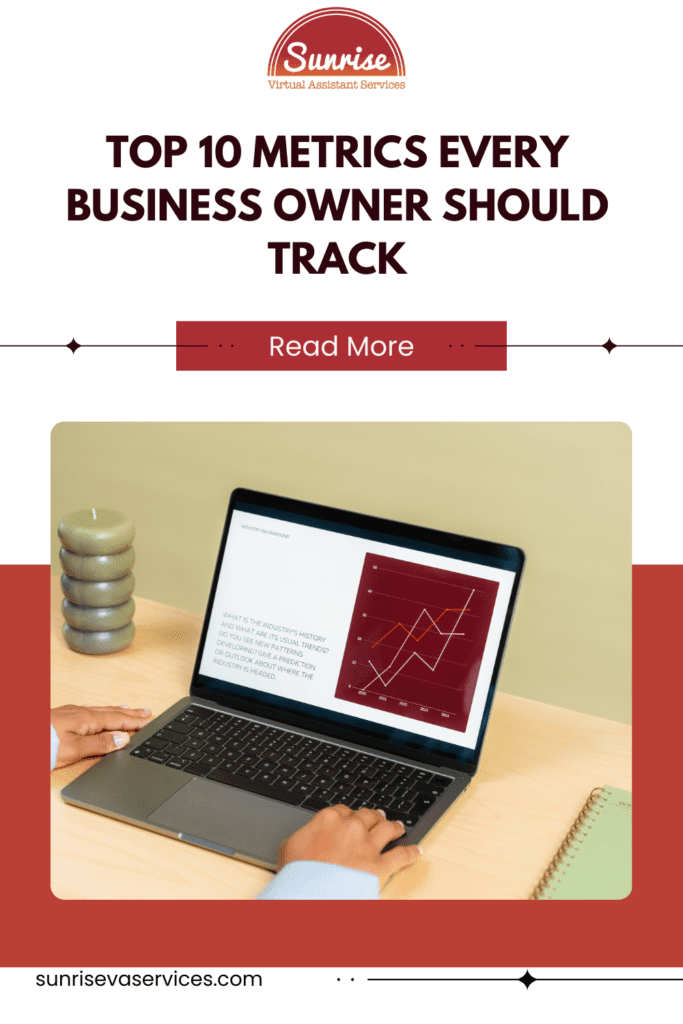Tracking the right metrics is the foundation of a successful business, and knowing which ones to focus on is essential for making better, data-driven decisions.
From tracking cash flow to assessing customer satisfaction, understanding the essential metrics every business owner should monitor can inspire valuable insights.
It’s these insights (when used correctly) that elevate daily operations and lay the foundation for expansion.
But with so many metrics available, how do you decide which ones are vital to your business’s performance?
This article breaks down the top 10 key metrics every business owner should track, helping you align your goals, identify areas of improvement, and make smarter business decisions.
Don’t worry if these metrics seem overwhelming; there’s much to consider. We’ll also explain how Sunrise Virtual Assistant Services can effectively support your efforts.
Let’s dive in…
Why Monitoring Key Metrics Matters
Gaining an understanding of these essential metrics will provide valuable insights and perspective into your business’s financial health, customer base, and overall potential for growth.
After all, you can’t effectively plan if you don’t have all the information.
When your data is accurate and structured, this enables you to stay on the right track toward achieving sustainable growth while addressing challenges in real time.
Whether you’re a small business owner or leading a larger team, these metrics are your roadmap to business success.
10 Metrics Every Business Owner Should Track
1. Total Revenue
This critical metric measures the total amount of money your business earns during a specific time period. Keeping an eye on your total revenue helps you understand whether your sales efforts and marketing campaigns are effectively growing your income.
Total Revenue Formula
Total Revenue = Total Sales Revenue
Use this metric to ask yourself whether you’re hitting your targets, which marketing channels drive the most sales, and if there’s growth potential in new markets.
2. Gross Profit Margin
Your gross profit margin reveals the total income left after covering the cost of goods sold (COGS).
Essentially, it shows how efficiently your business creates profit compared to its variable costs.
Formula:
(Total Revenue – Cost of Goods Sold) ÷ Total Revenue x 100
If your profit margin is low, it could be a sign to reassess operational costs and pricing strategies or negotiate better supplier terms.
3. Net Profit Margin
This metric measures how much profit remains after accounting for all operational costs, marketing expenses, sales commissions, taxes, and other costs.
Yes, it’s a very important metric!
Net profit margin is basically an indicator of your business’s financial health and the effectiveness of your overall strategies.
Formula:
(Net Income ÷ Total Sales) x 100
Monitoring this regularly ensures you generate a positive return and allows you to evaluate whether to invest in growth initiatives.
These initiatives might look like expanding your customer base or increasing your Google ad spend.
4. Customer Acquisition Cost (CAC)
This metric is a handy one! Your CAC measures how much money it takes to acquire a new customer. This helps you evaluate the efficiency of your marketing efforts and sales team.
Formula:
(Total Marketing and Sales Expenses in a Specific Period ÷ Number of New Customers)
Monitor this closely! If your Customer Acquisition Cost (CAC) is continuously rising, consider optimizing your marketing channels or reevaluating your business model to enhance efficiency.
Always look for ways to optimize as costs rise as well.
5. Customer Lifetime Value (CLV)
Some metrics are often forgotten, and this is one of them. Your customer lifetime value reflects the total revenue you can expect from one single customer over the course of their relationship with your business.
A high CLV signals to a loyal customer base and effective retention strategies.
Formula:
Average Transaction Value × Frequency of Purchases × Customer Lifespan
To boost customer lifetime value, try focusing on some cool retention strategies like loyalty programs, awesome customer service, and making sure you provide a fantastic user experience.
6. Customer Churn Rate
Some metrics are seldom revisited until there’s a red flag.
Your churn rate identifies the percentage of customers who stop purchasing from your business during a specific period of time.
A high churn rate may indicate problems with customer service, product satisfaction, or unmet expectations.
Formula:
(Number of Customers Lost in a Period ÷ Total Customers) x 100
Regularly track churn rates and address root causes by improving customer experience and responding to all feedback, both positive and negative.
7. Inventory Turnover
Here’s an easy one (but you still shouldn’t forget it!).
For product-based businesses, tracking your inventory turnover rate ensures you manage stock efficiently and minimize overstocking or understocking issues.
Yes, it’s business 101, but worth mentioning.
Formula:
Cost of Sales ÷ Average Inventory
Low turnover could indicate over-purchasing or outdated inventory, while high turnover signals strong demand.
8. Conversion Rate
A strong conversion rate reflects the effectiveness of your marketing efforts and sales team.
Whether it’s turning website visits into purchases or inquiries into hires, this key metric tracks the number of desired actions your target audience takes.
Formula:
(Number of Conversions ÷ Number of Visitors) x 100
Identify the best way to improve this by tracking across marketing campaigns and optimizing weak points (like your website’s landing page or checkout experience).
9. Net Promoter Score (NPS)
NPS gauges customer satisfaction and measures how likely customers are to recommend your business to others.
Formula:
% of Promoters – % of Detractors
This metric is critical for understanding your customers’ loyalty and overall perception of your brand, enabling you to refine services and build on positive feedback.
10. Burn Rate
For startups or growing small businesses, the burn rate measures how quickly your company is spending it’s cash reserves.
Tracking this ensures you maintain positive cash flow and allows you to plan effectively for the long-term growth of your business.
Formula:
Monthly Operating Expenses ÷ Total Bank Accounts/Cash Reserves
A lower burn rate reduces financial strain and increases your business growth runway.
Managing Metrics with Virtual Assistant Services
Keeping up with those key business metrics is super important, but let’s be honest—it can get overwhelming when you try to track them all the time.
That’s where Sunrise Virtual Assistant Services steps in to lighten the load and help you stay on top of things!
Here’s how hiring a reliable virtual assistant can help you simplify your business management tasks:
- Effortless Data Collection: Virtual assistants can automate data collection and organize accurate data for these metrics, giving you more time to focus on strategy.
- Streamlining Reports: They can set up regular performance summaries using tools like Google Analytics or Excel, so everything you need is at your fingertips.
- Customer Feedback Management: From analyzing NPS to monitoring customer attrition, our virtual team can ensure your customers stay happy and engaged.
- Administrative Support: Whether it’s scheduling meetings, managing social media, or preparing detailed financial insights, our team is ready to ease your workload.
At Sunrise Virtual Assistant Services, we pride ourselves on being more than just support staff—we’re your trusted partner in achieving business success and making every day-to-day task more manageable.
Take Control of Your Business Metrics Today
Tracking the most important metrics is the foundation of understanding your business’s performance and unlocking your growth potential. Whether you’re improving operational efficiency, reducing costs, or building stronger customer connections, these metrics serve as your ultimate guide.
If you’re ready to make smarter, data-driven decisions, but need a helping hand to manage the details, contact Sunrise Virtual Assistant Services today.
From handling business admin tasks to optimizing your operations, we’re here to give you the time and tools you need to thrive.
By properly tracking the top 10 metrics every business owner should track, you’re setting the stage for sustainable growth and ensuring your business is always on the right track toward success.
FAQ
1. Why is tracking business metrics important?
Tracking business metrics is essential because it provides insights into your business’s performance, helps identify areas for improvement, and enables data-driven decisions that lead to growth and success.
2. What are the top metrics every business owner should track?
While every business is different, some key metrics include operational efficiency, customer satisfaction, revenue growth, cost management, and engagement levels. These metrics provide a good foundation for understanding your business’s health.
3. How can Sunrise Virtual Assistant Services help me manage my metrics?
Sunrise Virtual Assistant Services can support your business by handling time-consuming administrative tasks, organizing data, and optimizing operations, so you can focus on analyzing and improving your metrics effectively.
4. Can tracking metrics help reduce costs?
Absolutely! By closely monitoring and analyzing your metrics, you can identify inefficiencies, make strategic adjustments, and effectively reduce unnecessary costs, contributing to improved profitability.
5. How do I get started with Sunrise Virtual Assistant Services?
It’s simple! Reach out to us today to discuss your needs. We’ll work with you to create a tailored solution allowing you to control your business metrics and achieve your goals.


